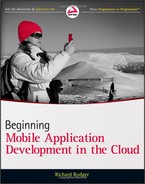Book Description
Learn how to build apps for mobile devices on Cloud platforms
The marketplace for apps is ever expanding, increasing the potential to make money. With this guide, you'll learn how to build cross-platform applications for mobile devices that are supported by the power of Cloud-based services such as Amazon Web Services. An introduction to Cloud-based applications explains how to use HTML5 to create cross-platform mobile apps and then use Cloud services to enhance those apps. You'll learn how to build your first app with HTML5 and set it up in the Cloud, while also discovering how to use jQuery to your advantage.
Highlights the skills and knowledge you need to create successful apps for mobile devices with HTML5
Takes you through the steps for building web applications for the iPhone and Android
Details how to enhance your app through faster launching, touch vs. click, storage capabilities, and a cache
Looks at how best to use JSON, FourSquare, jQuery, AJAX, and more
Shares tips for creating hybrid apps that run natively
If you're interested in having your application be one of the 200,000+ apps featured in the iPhone store or the 50,000+ in the Android store, then you need this book.
Table of Contents
- Cover
- Introduction
- Chapter 1: Introducing Cloud-Based Mobile Apps
- Chapter 2: Mobilizing Your App
- Chapter 3: Building Mobile Web Apps
- Chapter 4: Enhancing Your App
- Chapter 5: Building Apps in the Cloud
- Chapter 6: Use the Cloud!
- Chapter 7: Enhancing the User Experience
- Chapter 8: Working with the Cloud
- Chapter 9: Creating Hybrid Apps that Run Natively
- Chapter 10: Building a Photo-Blogging App
- Chapter 11: Working with Cloud Development Services
- Chapter 12: Going Social!
- Chapter 13: App Stores
- Chapter 14: Selling Your App
- Appendix: Exercise Solutions
